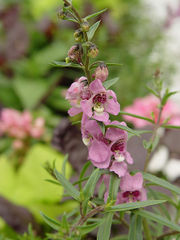Angelonia: Difference between revisions
No edit summary |
No edit summary |
||
| (One intermediate revision by one other user not shown) | |||
| Line 1: | Line 1: | ||
{{ | {{SPlantbox | ||
| | |familia=Scrophulariaceae | ||
| | |genus=Angelonia | ||
| image = Maypurpleflower.jpg | |Temp Metric=°F | ||
| image_width = | |jumpin=If this plant info box on watering; zones; height; etc. is mostly empty you can click on the edit tab and fill in the blanks! | ||
| image_caption = ''Angelonia angustifolia'' | |image=Maypurpleflower.jpg | ||
|image_width=180 | |||
|image_caption=''Angelonia angustifolia'' | |||
}} | |||
'''''Angelonia''''' is a [[genus (biology)|genus]] of about 30 [[species]] native to [[South America]]. Some species are cultivated as [[ornamental plant]]s for their [[Antirrhinum|snapdragon]]-like flowers. | |||
| | {{Inc| | ||
Angelonia (South American name, angelón, of one of the species). Scrophulariaceae. Perennial herbs or sub-shrubs, grown in hothouses and conservatories, and in the open far South. | |||
Plants with the look of alonsoas: Lvs. simple, opposite (or alternate above): fls. showy, blue, irregularly 2-lipped, the upper lip 2-lobed and the lower larger and 3-lpbed; calyx 5-parted or 5-toothed; stamens 4, in pairs; ovary 2-celled. The axillary fls. are in a long, leafy terminal raceme: branches 4-sided.—About two dozen species from Mex. to Brazil. Grown as pot- plants in warm glasshouses and prop, by seeds or softwood cuttings. | |||
}} | |||
==Cultivation== | |||
===Propagation=== | |||
===Pests and diseases=== | |||
==Varieties== | |||
==Gallery== | |||
<gallery perrow=5> | |||
Image:Upload.png| photo 1 | |||
Image:Upload.png| photo 2 | |||
Image:Upload.png| photo 3 | |||
</gallery> | |||
==References== | |||
<references/> | |||
*[[Standard Cyclopedia of Horticulture]], by L. H. Bailey, MacMillan Co., 1963 | |||
<!--- xxxxx *Flora: The Gardener's Bible, by Sean Hogan. Global Book Publishing, 2003. ISBN 0881925381 --> | |||
<!--- xxxxx *American Horticultural Society: A-Z Encyclopedia of Garden Plants, by Christopher Brickell, Judith D. Zuk. 1996. ISBN 0789419432 --> | |||
<!--- xxxxx *Sunset National Garden Book. Sunset Books, Inc., 1997. ISBN 0376038608 --> | |||
==External links== | |||
*{{wplink}} | |||
{{ | {{stub}} | ||
__NOTOC__ | |||
Latest revision as of 20:28, 14 January 2010
| Angelonia subsp. var. | ||||||||||||||||||||||||||||||||||||||||||||||||||||||||
|---|---|---|---|---|---|---|---|---|---|---|---|---|---|---|---|---|---|---|---|---|---|---|---|---|---|---|---|---|---|---|---|---|---|---|---|---|---|---|---|---|---|---|---|---|---|---|---|---|---|---|---|---|---|---|---|---|

|
|
| ||||||||||||||||||||||||||||||||||||||||||||||||||||||
| ||||||||||||||||||||||||||||||||||||||||||||||||||||||||
Angelonia is a genus of about 30 species native to South America. Some species are cultivated as ornamental plants for their snapdragon-like flowers.
| Standard Cyclopedia of Horticulture |
|---|
|
Angelonia (South American name, angelón, of one of the species). Scrophulariaceae. Perennial herbs or sub-shrubs, grown in hothouses and conservatories, and in the open far South. Plants with the look of alonsoas: Lvs. simple, opposite (or alternate above): fls. showy, blue, irregularly 2-lipped, the upper lip 2-lobed and the lower larger and 3-lpbed; calyx 5-parted or 5-toothed; stamens 4, in pairs; ovary 2-celled. The axillary fls. are in a long, leafy terminal raceme: branches 4-sided.—About two dozen species from Mex. to Brazil. Grown as pot- plants in warm glasshouses and prop, by seeds or softwood cuttings.
|
Cultivation
Propagation
Pests and diseases
Varieties
Gallery
-
photo 1
-
photo 2
-
photo 3
References
- Standard Cyclopedia of Horticulture, by L. H. Bailey, MacMillan Co., 1963
External links
- w:Angelonia. Some of the material on this page may be from Wikipedia, under the Creative Commons license.
- Angelonia QR Code (Size 50, 100, 200, 500)
